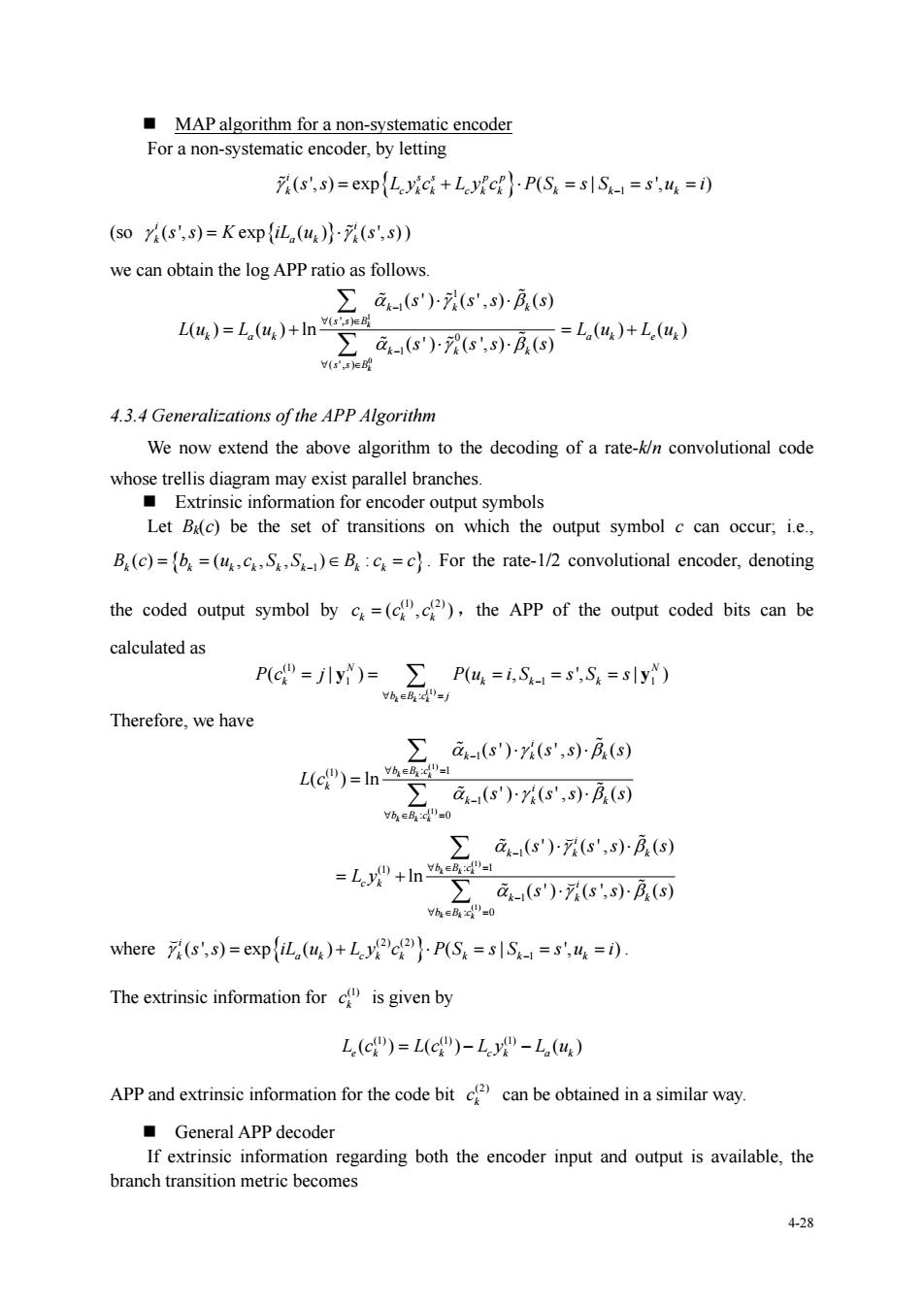正在加载图片...

MAP algorithm for a non-systematic encoder For a non-systematic encoder,by letting (s',s)=expLyici+LyfcP(S,=sIS=s'.u =i) (so r(s'.s)=K exp (iL(ug)(s'.s)) we can obtain the log APP ratio as follows ∑a(心')(s',s)序(s) ()=L,(u)+ln 2a()s5A西L,)+4仙) 4.3.4 Generali-ations of the APP Algorithm We now extend the above algorithm to the decoding of a rate-k/n convolutional code whose trellis diagram may exist parallel branches. Extrinsic information for encoder output symbols Let B(c)be the set of transitions on which the output symbol c can occur,ie B(c)=b=(uc,S,S)EB:c=c).For the rate-1/2 convolutional encoder,denoting the coded output symbol by c=(c),the APP of the output coded bits can be calculated as P(d"=jly ) ∑Pu=i,S=s,S4=sly) YheBd-j Therefore,we have c)=n ∑a(s')(s',)月(s) =L”+ns写 ∑a(s')75',B.(s) vh where (s'.s)=expiL(ug)+LycP(S:=sIS-=s',u=i) The extrinsic information forc is given by L.(c")=L(c")-Ly"-L() APP and extrinsic information for the code bit can be obtained in a similar way. ■General APP decoder If extrinsic information regarding both the encoder input and output is available.the branch transition metric becomes 4-284-28 MAP algorithm for a non-systematic encoder For a non-systematic encoder, by letting 1 ( ', ) exp ( | ', ) i ss pp k c kk c k k k k k s s Lyc Lyc PS s S s u i (so ( ', ) exp ( ) ( ', ) i i k ak k s s K iL u s s ) we can obtain the log APP ratio as follows. 1 0 1 1 ( ', ) 0 1 ( ' , ) ( ' ) ( ' , ) ( ) ( ) ( ) ln ( ' ) ( ', ) ( ) k k kk k ss B k ak kk k ss B s ss s Lu L u s ss s () () Lu Lu ak ek 4.3.4 Generalizations of the APP Algorithm We now extend the above algorithm to the decoding of a rate-k/n convolutional code whose trellis diagram may exist parallel branches. Extrinsic information for encoder output symbols Let Bk(c) be the set of transitions on which the output symbol c can occur; i.e., Bk k kk k k k k () ( , , , ) : c b ucSS B c c 1 . For the rate-1/2 convolutional encoder, denoting the coded output symbol by (1) (2) (, ) k kk c cc ,the APP of the output coded bits can be calculated as (1) (1) 1 11 : ( | ) ( , ', | ) k k k N N k kk k b Bc j Pc j Pu iS s S s y y Therefore, we have (1) (1) 1 (1) : 1 1 : 0 ( ' ) ( ' , ) ( ) ( ) ln ( ' ) ( ' , ) ( ) k k k k k k i kk k b Bc k i kk k b Bc s ss s L c s ss s (1) (1) 1 (1) : 1 1 : 0 ( ' ) ( ' , ) ( ) ln ( ' ) ( ', ) ( ) k k k k k k i kk k b Bc c k i kk k b Bc s ss s L y s ss s where (2) (2) 1 ( ', ) exp ( ) ( | ', ) i k a k ck k k k k s s iL u L y c P S s S s u i . The extrinsic information for (1) k c is given by (1) (1) (1) ( ) ( ) () L c Lc Ly L u e k k ck a k APP and extrinsic information for the code bit (2) k c can be obtained in a similar way. General APP decoder If extrinsic information regarding both the encoder input and output is available, the branch transition metric becomes